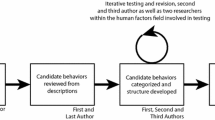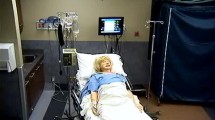Abstract
The detailed analysis of team interactions can be a source of insight into team processes and how teams interact with technology. Video recordings afford an exciting medium for such analysis. We describe a study of team leadership in the highly dynamic, high-stakes environment of trauma resuscitation. The study was conducted through video recording team activities in actual work settings and analysing the video data using a grounded theory approach. The primary research questions were: what are the functions of team leadership and how do they vary according to task situations? A corpus of 152 video segments from 18 trauma patient resuscitation cases was compiled to address these research questions. A catalog of team leadership functions was developed, along with a categorisation of the task situations in which team leadership occurred. The implications of this catalog and the mapping between leadership and task situations are discussed in relation to the findings from an interview study and a survey study on team leadership. The methodological advantages of a grounded theory approach for in-context video analysis for studying work are also discussed.

Similar content being viewed by others
References
Avolio BJ, Jung DI, Murry W, Sivasubramaniam N (1996) Building highly developed teams: focusing on shared leadership processes, efficacy, trust, and performance. In: Beyerlein MM, Johnson DA, Beyerlein ST (eds) Advances in interdisciplinary studies of work teams: team leadership. JAI Press Inc., Greenwich, CT, pp 173–209
Chemers MM (1997) An integrative theory of leadership. LEA, Mahwah, NJ
Dowrick PW, Biggs SJ (1983) Using video—psychological and social applications. Wiley, Chichester, UK
French JRP Jr, Raven B (1959) The bases of social power. In: Cartwright D (ed) Studies in social power. University of Michigan Press, Ann Arbor, MI, pp 150–167
Glaser B, Strauss A (1967) The discovery of grounded theory. Aldine, Chicago
Hoyt DB, Shackford SR, Fridland PH, Mackersie RC, Hansbrough JF, Wachtel TL et al. (1988) Video recording trauma resuscitations: an effective teaching technique. J Trauma 28:435–440
Mackenzie CF, Xiao Y and The LOTAS Group (1999) Video analysis for performance modeling in real environments: methods and lessons learnt. In: Proceedings of the 43rd annual meeting of the human factors and ergonomics society, Houston, TX, 27 September-1 October 1999-
Mackenzie CF, Hu P, Xiao Y, Seagull JF (2003) Video acquisition and audio system network (VAASNET) for analysis of workplace safety performance. Biomed Instrum Technol
Orasanu JM (1994) Shared problem models and flight crew performance. In: Johnston N, McDonald N, Fuller R (eds) Aviation psychology in practice. Ashgate Publishing Company, Brookfield, CT, pp 255–285
Orasanu J, Salas E (1993) Team decision making in complex environments. In: Klein GA, Orasanu J, Calderwood R, Zsambok CE (eds) Decision making in action: models and methods, Ablex, Norwood, MA, pp 327–345
Parry KW (1998) Grounded theory and social process: a new direction for leadership research. Leadership Q 9(1):85–105
Sanderson PM, Fisher C (1994) Exploratory sequential data analysis: foundations. Hum Comput Interact 9:251–317
Strauss A, Corbin J (1990) Basics of qualitative research: grounded theory, procedures, and techniques. Sage Publications, Newbury Park, NJ
Swezey RW, Salas E (1992) Teams: their training and performance. Ablex, Norwood, MA
Tardiff K, Redfield J, Koran LM (1978) Evaluation of a videotape technique for measuring clinical psychiatric skills of medical students. J Med Educ 53:438–440
Vecchio RP (1997) Leadership: understanding the dynamics of power and influence in organization. University of Notre Dame Press, Notre Dame, IN
Vroom VH, Yetton PW (1973) Leadership and decision making. University of Pittsburgh Press, Pittsburgh, PA
Xiao Y, Mackenzie CF (1998) Micro-theory methodology in critical incident analysis. In: 1998 proceedings of IEEE international. In: Proceedings of the conference on systems, man, and cybernetics, Tokyo, Japan, October 1999
Yun S, Faraj S, Xiao Y, Sims HP Jr (2003) Team leadership and coordination in trauma resuscitation. In: Beyerlein MM, Johnson DA, Beyerlein ST (eds) Team-based organizing. JAI, Amsterdam, pp 189–214
Ziegert J, Klein KJ, Xiao Y (2001) Team leadership: a review and extension of existing theory through a qualitative study of shock trauma teams. In: Proceedings of the annual meeting of the academy of management, Washington, DC, August 2001
Acknowledgements
The work reported here was supported by the Army Research Institute (DASW 01-99-K-0003) and National Science Foundation (IIS-9900406). The opinions expressed here are those of the authors and do not reflect the official positions of the funding agencies. The authors wish to thank the assistance of Jacqueline Moss, Rebecca Roys, Paul Regnault and Jonathan Ziegert and the support of the clinicians who participated in the study reported here. Jean MacMillan also provided valuable contributions to the revision of an earlier version of the paper.
Author information
Authors and Affiliations
Corresponding author
Rights and permissions
About this article
Cite this article
Xiao, Y., Seagull, F.J., Mackenzie, C.F. et al. Adaptive leadership in trauma resuscitation teams: a grounded theory approach to video analysis. Cogn Tech Work 6, 158–164 (2004). https://doi.org/10.1007/s10111-004-0157-z
Received:
Accepted:
Published:
Issue Date:
DOI: https://doi.org/10.1007/s10111-004-0157-z




